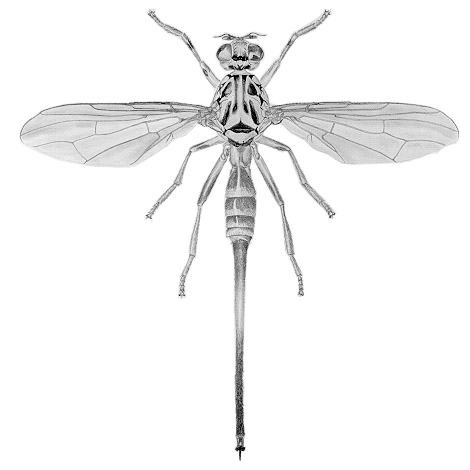Michael spotted a papaya fruit fly (AKA papaya wasp) on a green papaya and has well-founded concern for his fruit:
“Quick question about papaya wasps. I was checking out my plants this past weekend and spied what I believe was one of the adults on an immature fruit. How worried should I be? We live in Hillsborough County in the Forest Hills area. The cold is more tempered in this area due to several large lakes nearby, so I’m not worried about the plants freezing, but I am a little worried about the wasps now. I haven’t seen them before on my trees.”
The Strange Papaya Fruit Fly
Though they look like wasps, the papaya wasp is actually the papaya fruit fly. They don’t look like any fruit fly you’ve ever seen, however.

Illustration from the Division of Plant Industry
You can see why they’re often called the “papaya wasp.”
They’re really an attractive insect for such a pain-in-the-neck pest.
Michael is correct to be concerned – these are a huge problem for papaya growers.
Why is it after green papaya?
If you see a papaya fruit fly near your immature fruit, chances are that fruit is going to be filled with maggots when ripe.
As UF states in an article on the papaya fruit fly:
“The female is capable of producing 100 or more eggs. The female fruit fly oviposits in the green immature fruit by thrusting her ovipositor through the flesh of the fruit. She then deposits a group of 10 or more long, slender eggs in the papaya’s central cavity where the young larvae feed on developing seeds and the interior parts of the fruit. As the larvae mature, they eat their way out of the fruit, drop to the ground beneath the plant, and pupate just below the soil surface. Flies emerge in about two to six weeks, depending upon humidity and temperature of the soil.
Eggs are usually laid in small fruit, about two to three inches in diameter, but they may be deposited in smaller or larger fruit. However, unripe papaya juice is fatal to the larvae so the fruit must be ripe before the larvae begin to eat their way out of the inner cavity. Eggs hatch approximately 12 days after oviposition and larval development in the fruit lasts about 15 to 16 days.”
In the southern part of the state and warmer regions along the coast, the papaya fruit fly is a serious pest. I never had trouble with them in the Ocala/Gainesville area due to the freezes, but in The Great South Florida Food Forest Project they are a repeating problem.
I remember the first time I picked a beautiful ripe papaya for mom and opened it up to find it squirming with papaya fruit fly maggots.
Nasty.
Papaya Fruit Fly Control
Though you could probably hire a crop-duster, a better approach is to manage papaya fruit flies without pesticides by being pro-active.
My advice: keep an eye on those fruit. If any fall off, burn or bury them deeply. If they ripen, be prepared for a maggot fest – and again, don’t just compost the fruit or toss it somewhere – kill those maggots! Sanitation is key to papaya fruit fly control. The last thing you want is hundreds more of them buzzing around your neighborhood.
If you have very young fruit you can bag them to prevent infection. For fruit that are already larger, just watch them. It’s probably too late to bag.
Good luck. I’m sorry they found you. Keep a close eye on your trees, destroy infected fruit without prejudice and bag the little ones – and pray these obnoxious pests don’t come back.


11 comments
Keep an eye on the fruit….keep an eye on the fruit….keep an eye on the FRUIT!
I’m going to try bagging with nylons and paper bags. Has any one else had success with this method? I live in Hillsboro County as well.
The ads on your web page prevent any reasonable attempt to read information from the page. Perhaps you think you are being clever to entice me kinto some subscription or membership. Wrong. I’ll seek and find the information I am looking for elsewhere. If you were unaware of this bombardment, now you are. The expression is, one catches more flies with honey than vinegar.
Thanks, Peter. I am torn on the ads and have considered ditching them. They pay out hundreds per month, and this blog doesn’t make much otherwise. It’s a balance.
Website frequently say ‘Destroy the fruit’, but fail to explain how to do that effectively. I’ve read that you can put the fruit in a plastic sealed bag and place in the sun, but papaya is generally a big fruit. Any other suggestions?
Bury in a pit, throw in a fire, toss into a canal, stick them in the freezer overnight, smash on the driveway and stomp – there are some options. Fire would be my favorite.
Is it safe to just eat them if there are only a few?
I microwave it
I open it to see if it’s infected (it usually is)
Then I put it in the microwave for 3 minutes.
nylon knee stocks
I had this problem in my papaya farm. Initially, I controlled it by spraying Imidacloprid systemic pesticides on the fruits. Then I switched to Neem oil.
Is it ok to eat them if you only have a few?
Mine are so small. Mayne 1 inch and white but almost translucent.
Comments are closed.